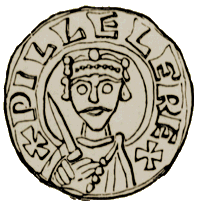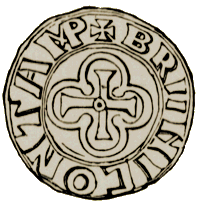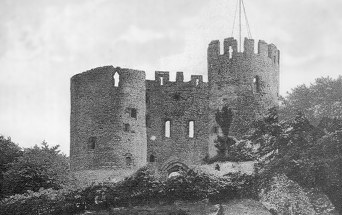|
The Normans were descended from Vikings who
had settled in Normandy, married into the local population and
adopted the French culture. After the invasion they quickly
gained control of the southern part of the county, but were met
with hostility in the north and east.
King William initially had control of the
old kingdoms of Essex, Kent, Wessex, Sussex and part of Mercia.
Edwin Earl of Mercia and his brother Morcar, Earl of
Northumbria, were delighted that William had overthrown the
Godwin family in Wessex and believed that he would be satisfied
with the territory he had already gained and so would leave them
in control of their kingdoms. If they had understood their true
situation and attacked William before he became established,
they may have been able to overthrow him. |
|

| An engraving of a
silver penny from King William's reign. |
|
Three months after his coronation, King William
returned to France and took with him the people who were most
likely cause any trouble while he was away, including Edwin and
Morcar. During his absence, unrest began to grow and there was
an attempted invasion by Eustace, Count of Bolougne, who was
Edward the Confessor’s brother-in-law.
William hastily returned in December 1067 and set about
consolidating his hold on the country. He took Exeter after an
18 day siege and began to build castles at important sites. His
wife Matilda arrived here in 1068 and was crowned Queen. When he
returned to Normandy in 1069
one of his most formidable lieutenants, Robert de Commines, and
500 of his followers were slaughtered after a drunken debauch in
Durham.
|
|
The Norman castle at York was besieged and on the king’s return he
put down the rebellion and sacked York. William was hated by
many of the English and more resistance to his rule was to
follow.
William and his army swept through the northern counties from
Shropshire to Durham and the Scottish borders on a mass killing
spree. Villages were burned, animals slaughtered, crops
destroyed and any survivors were left to starve. This led to the
deaths of over 100,000 people and effectively ended any further
resistance in this part of the country.
A
Danish fleet arrived off the Northumbrian coast to lend support
to the general uprising. This was led by King Swein who
had as much claim to the English throne as William, if not more.
He was the nephew of King Canute and was joined by
Edgar the Atheling who was the main English claimant to the
throne. William managed to buy-off the Danes and Edgar fled to
Scotland.
The
final English revolt took place in the fenlands of East Anglia in 1071. Hereward the Wake led a number of raids on
the Normans from the safety of the marshes around Ely. He was
joined by Earl Morcar, whose brother Edwin had been murdered by
his own men. William sent troops into the marshes and defeated
the Saxons. Hereward escaped but Morcar was captured and
imprisoned.
William felt that he could not trust the
Saxons at all and the remaining Saxon landowners had their lands
taken away, to be given to trusted Normans. After 1066 most of
Mercia still belonged to Earl Edwin of Mercia, but after his
death the estates were divided amongst William’s followers. Much
of local Mercia including Upper and Lower Penn was given to
Ansculf of Picuigny who built a motte and bailey castle at
Dudley.
|
| Under William the medieval feudal system continued
to be used. William owned all of the land and divided it up into
areas, which were each ruled by a tenant in chief who was one of
his trusted barons. They each controlled their area in return
for payment from taxes and supplied soldiers for the king’s
army. Each area was divided into smaller areas (manors) that
were controlled by the baron’s knights who were called lesser or
mesne tenants. They had to take an oath of loyalty, carry out
any required duties and pay taxes for their land. Each manor
would include several villages whose inhabitants were called
peasants. There were several classes of peasant. The highest was
a freeman who was free to pursue a trade. The other classes were
owned as part of the land and were not free to move around. |

An engraving of the reverse side of a
silver penny from William's reign. |
| They were villiens, bordars, cottars and serfs.
A villien offered agricultural services to his lord, a bordar
was a smallholder who farmed on the edge of a settlement, a
cottar was a cottager and a serf was an agricultural labourer.
In return the lord of the manor was supposed to protect and help
them. The other major landowner was the church and bishops and
abbots could be tenants in chief or lesser tenants.
As the country settled down under Norman
rule, William wanted to ensure that he received all of the taxes
that were owed to him. This was very complex because the country
had been divided into a large number of tax paying manors. The
solution was the Domesday Book and work on it began in 1085 when
teams of investigators toured the country. The information
gathered from all over the country was collated into the book at
Winchester and from this precise taxes could be calculated.
When a team of investigators arrived in an
area they would meet with the landowner, the local priest and a
group of older villagers. The information gathered was as
follows:
The name of each tenant-in-chief, tenant and
under-tenant, the total amount of land, the amount of land under
cultivation, the amount of woodland, the number of people,
animals and ploughs and any fishponds or mills.
The Domesday Book was not completed until
after King William’s death on
9th September 1087. Today it is the most important source of
information about village life in the Middle Ages.
The
entries for Penn are as follows:
Upper
Penn, called “Penna”:
William Fitzansculph holds Upper Penn. There are 5 hides. Robert
(his vassal) holds it from him. Earl Algar held it. There is
land for 6 ploughs. In the lordship, 1 plough with one slave.
There are 8 villagers and two smallholders with 1 plough. There
is a mill worth 2 shillings. The value was and is 30 shillings.
Lower
Penn, called “Penne”:
William Fitzansculph owns it. There are 3 hides. Gilbert (his
vassal) holds it from him. Countess Godiva held them. There is
land for 6 ploughs. In the lordship land for one. There are 6
villagers with one freeman. They have one and a half ploughs.
There are four acres of meadow. Lower Penn is valued at twenty
shillings for taxable purposes.
|

| A view of the 13th
and 14th century keep at Dudley Castle from an old
postcard. The later castle is on the site of
William Fitzansculph's home. |
|
At that time Penn was no more than a tiny hamlet with no wealthy
people living there. Upper Penn was a little larger and more
valuable than Lower Penn.
The
mill mentioned in Upper Penn would be a watermill because
windmills did not appear in England until the 12th century.
The most logical place to find such a mill would have been at
the bottom of Penn Common. So maybe there was an 11th
century watermill near to the present day Wodehouse Mill.
|
|
The
owner of Penn, William Fitzansculph was Ansculf’s son and
would have inherited his father’s land and possessions on his
death, which must have been sometime before 1085. Ansculf was in
control of more than 80 manors, scattered across several
counties and like his father William was based at Dudley Castle.
Very little remains of the 11th century buildings,
most of what we see today dates from the 14th
century.
William Fitzansculph’s holdings included Amblecote,
Aston, Birmingham, Bushbury, Chasepool, Dudley, Edgbaston,
Enville, Erdington, Essington, Great Barr, Handsworth, Himley,
Moseley, Newport Pagnell, Orton, Oxley, Pendeford, Perry Barr,
Sedgley, Seisdon, Trysull, Witton, Wombourne, and Upper
Penn and Lower Penn.
William’s tenant at Upper Penn was Robert,
who was also tenant at some of William’s other holdings,
including Bushbury, Ettingshall, Moseley and Oxley. His tenant
at Lower Penn was Gilbert.
By the end of the 11th century
Penn was firmly on the map as a small farming community, just as
parts of it still are today. |

|
|

|
|

|
| Return to
Godiva, Leofric and Algar |
|
Return to
the contents |
|
Proceed to
Medieval Penn |
|